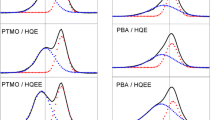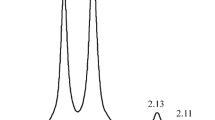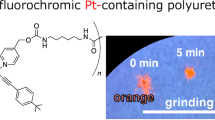Abstract
New segmented polyurethaneimides containing poly(ethylene glycol adipate) soft segments and bis(urethaneimide) hard segments are synthesized. Copolymers are obtained on the basis of poly(ethylene glycol adipate) (Mn = 2.5 × 103) terminated with 2,4-toluene diisocyanate, two aromatic dianhydrides, and six aromatic diamines. The structure of the synthesized polymers is studied by IR and NMR spectroscopy. The thermal properties of the copolymers are characterized by TGA and DSC. Effects of hard segment length and substituent position in the diamine fragment on the thermal and mechanical properties of the polyurethaneimides are investigated.
Similar content being viewed by others
Explore related subjects
Discover the latest articles, news and stories from top researchers in related subjects.Avoid common mistakes on your manuscript.
INTRODUCTION
Block copolymers have been known since the middle of the 20th century. However, the interest in them does not wane, since they allow macroscopic properties of two different polymers to be combined in a single material or synergic effects to be reached. The structure of block copolymers is multivariate in the architectural respect, and the block copolymers of type [A–B]n are commonly assigned to multiblock (segmented) polymers [1, 2]. By definition, each repeat unit of these polymers contains hard monomer block A and flexible-chain polymer block B; blocks A and B are thermodynamically incompatible. A characteristic feature of multiblock copolymers of type [A–B]n is the microphase separation of blocks A and B accompanied by the formation of corresponding nanodomains and microdomains in the copolymer bulk.
Polyurethanes are the typical representatives of multiblock block copolymers. Polyurethanes belong to the circle of commercial elastomers that are used in many fields of engineering. Materials with diverse properties, from very soft foams to tough elastomers and wear-resistant coatings, are obtained on their basis [1]. However, the practical application of polyurethanes is limited by their low thermal stability, since the thermal destruction of polyurethanes starts even at about 200°С [3]. A promising approach to enhance the thermal stability and strength of polyurethane elastomers is their chemical modification via introduction of fragments of heterochain highly thermally stable polymers in the repeat units of chains. Presently, this direction of polyurethane modification is under the spotlight [3–8]. Particularly, in the last years, multiblock polyetherimides and polyurethaneimides (PUIs) [9–14] containing aromatic imide fragments have been investigated successfully. The introduction of imide fragments is dictated by the fact that polyimides possess high thermal and radiation stability, solvent resistance, and mechanical strength [15, 16]. The modification of polyurethanes by imide blocks makes it possible, on one hand, to consider PUIs as the products of polyurethane chemical modification, in which aromatic dianhydrides play the role of chain extension agents. On the other hand, these are the products of modification of thermally stable polyimides with aliphatic polyester blocks being introduced into the structure of repeat units.
The aim of the present work is to synthesize and investigate thermal and mechanical properties of novel PUIs with the chemical structure consisting of the same poly(ethylene glycol adipate) soft segment and variable imide aromatic moieties. The latter play the role of hard segments comprising aromatic diamines which differ in the number of oxyphenylene fragments and structural isomerism. Effects of the size and structural isomerism of the hard segment on the properties of the obtained film polymer materials are considered.
EXPERIMENTAL
Initial Reagents
2,4-Toluene diisocyanate (95%, Aldrich) was distilled in vacuum. N-methyl-2-pyrrolidone (MP) (98%, Aldrich) was kept above calcium hydride and distilled in vacuum. Pyromellitic dianhydride (97%, Aldrich) (1), p-phenylenediamine (98%, Aldrich) (a) and m-phenylenediamine (99%, Aldrich) (b) were sublimated in vacuum. Poly(ethylene glycol adipate) (Mn = 2500) (45 mg KOH/g) (Aldrich), 4,4'-(4,4'-isopropylidene-diphenoxy)bis(phthalic anhydride) (97%, Aldrich) (2), and 4,4'-diaminodiphenyl ether (97%, Aldrich) (c) were dried in vacuum. 1,4-Bis(4-aminophenoxy)benzene (98%, Aldrich) (d), 1,3-bis(4-aminophenoxy)benzene (98%, Aldrich) (e), and 4,4'-bis(4-aminophenoxy)diphenyl ether (f) were obtained via the published methods [17]. Tm = 123–125°C (published data, Tm = 124–125°C). Toluene (analytical grade, Vekton, Russia) was used without additional purification.
Methods
The ATR IR spectra of PUI films were recorded on a Bruker Vertex Fourier spectrometer equipped with a Pike attachment using Zn–Se crystals as ATR elements (reflection angle of 45°).
1H and 13C NMR spectra were registered at room temperature on a Bruker Avance 400 instrument in DMSO-d6.
TGA curves were obtained on a TG 209 F1 thermo-microbalance (NETZSCH, Germany) in the temperature range of 30–800°С at a heating rate of 10°С/min in an inert medium (argon). The sample weight was 2–3 mg.
The temperature transitions of multiblock copolymer films were determined by DSC on a DSC 204 F1 device (NETZSCH, Germany) at a heating rate of 10°С/min in the temperature range from –60 to 250°С in an inert medium (argon). The weight of the samples was 4–5 mg.
The temperature dependences of storage modulus Е ', loss modulus E '', and mechanical loss tangent tan δ of the film samples were obtained by dynamic mechanical analysis (DMA) on a DMA 242 C setup (NETZSCH, Germany). Measurements were performed at a frequency of 1 Hz with a film strain amplitude of 0.1% and a heating rate of 5°С/min.
The stress–strain curves of films were recorded with the use of an Instron 5940 universal testing system (Instron, United States) at a strain rate 50 mm/min.
Technique for the Synthesis Polyurethaneimides
The general scheme for the synthesis of PUIs is presented below:


As an example, the synthesis of the polymer obtained using dianhydride (1), poly(ethylene glycol adipate) (Mn = 2.5 × 103), 2,4-toluene diisocyanate, and p-phenylenediamine (а) is described.
The synthesis was carried out in a three-neck flask equipped with an inlet for argon and a mechanical stirrer. The flask was charged with 2.5 g (1 mmol) of poly(ethylene glycol adipate) and 0.348 g (2 mmol) of 2,4-toluene diisocyanate. The obtained mixture was stirred at 100°С for 1 h, and 0.436 g (2 mmol) of pyromellitic dianhydride was added. The resulting mixture was stirred for 2 h at 180°C. The formed melt was dissolved in 2 mL of MP and cooled to room temperature. Afterwards, 0.108 g (1 mmol) of p-phenylenediamine solution in 6 mL of MP was introduced in the as-obtained solution of the macromonomer containing terminal anhydride groups, and the mixture was stirred for 18 h to give rise to the polymer precursor—poly(amic acid).
The thermal imidization of the formed polyamic acid was conducted in the same flask in MP solution via heating in a constant argon flow under the following regime: 160°С, 30 min; 180°С, 2 h; and 190°С, 1 h. The evolving water was removed in the form of a toluene/water azeotrope with the use of a Dean-Stark trap. The obtained solution of PUI was used to cast coatings on a glass substrate, and 200-μm-thick films were prepared upon solvent removal via heat treatment in the following regime: 100°С, 18 h; 120°С, 1 h; 140°С, 1 h; 160°С, 1 h; and 180°С, 2 h.
All other PUIs and their films were obtained in a similar manner.
IR (ATR): ν 3446, 3339, 2951, 2872, 1778, 1720, 1599, 1535, 1373, 1123, 725 cm–1.
1H NMR (DMSO-d6): δ 9.92, 9.13, 8.42, 7.77–7.02, 4.11, 3.60, 2.31, 2.09, 1.54 ppm.
13C NMR (DMSO-d6): δ 173.1, 165.8, 153.9, 153.6, 137.6, 132.5, 132.2, 131.4, 131.1, 130.4, 127.7, 118.7, 68.7, 63.5, 35.5, 24.3, 17.3 ppm.
RESULTS AND DISCUSSION
The synthesis of PUI consists of two stages that are conducted in one reaction pot without separation of intermediate products. The first stage is the synthesis of a macromonomer—dianhydride containing urethane and imide groups. The macromonomer synthesis begins with the termination of diol by diisocyanate accompanied by the formation of urethane groups. The doubled amount of the dianhydride is introduced in the obtained macrodiisocyanate. This leads to the formation of imide cycles and evolution of carbon dioxide. The second stage; that is, polycondensation of the macromonomer containing terminal anhydride groups with diamine, occurs at room temperature in MP solution and yields poly(amic acid), which is further thermally imidized in solution to form the target PUI polymers.
The structure of the synthesized polymers was investigated by IR and NMR spectroscopy. The IR spectrum of the polymer obtained with the use of dianhydride 1 and p-phenylenediamine a contains characteristic absorption bands of cyclic imides at 1776 cm–1 (C=O symmetric stretching vibrations), 1373 cm–1 (C–N stretching vibrations), and 725 cm–1 (bending vibrations of imide cycles). The band in the range from 3300 to 3500 cm–1 is assigned to vibrations of urethane NH groups [18–20]. Absorption at 2800 cm–1 is related to СН vibrations in soft ether segments. In addition, a complex band at 1630–1770 cm–1 (C=O stretching vibrations of ester groups and urethane groups and asymmetric C=O vibrations of imide cycles) is present in the spectrum. The band at 1123 cm–1 corresponds to vibrations of С–О–С bonds in ether groups in the soft segment [20].
The 1H and 13C NMR spectra of polymer 1a show signals at 9.92 and 9.13 (NH urethane) and 2.09 ppm (CH3) and the signal at about 166 ppm (C=O imide cycles) and signals at 153.6 and 153.9 ppm (C=O urethane) characteristic of hard segments of PUIs [21, 22]. In the 1H NMR spectrum, broad intense signals at about 4.11, 3.60, 2.31, and 1.54 ppm (protons of CH2 groups) and a signal at 173.1 ppm characteristic of ester groups C=O are attributed to the soft polyether segment.
The thermomechanical characteristics of the polymers were determined by two independent methods, i.e., DMA and DSC (Table 1). It is seen that the glass-transition temperatures increase with increasing content of hard segments. This trend is observed for temperatures determined from the maxima of both loss modulus and mechanical loss tangent. With increasing temperature, the synthesized polymers undergo transitions to the rubbery state (the storage modulus becomes temperature-independent). Figure 1 presents the data on the thermomechanical analysis of film samples of polymers 1a and 2a. It is seen that the storage modulus reaches a plateau at about 50°С continuing until either sample disruption at about 170°С (polymers 1) or melting at about 250°С (polymers 2). A lower heat resistance of PUIs obtained with the use of pyromellitic dianhydride is probably associated with the size of hard segments insufficient to form a strong network of physical crosslinks [23].
The glass-transition temperatures Тg, melting temperatures Тm, and melting enthalpies ΔН for the block copolymers are summarized in Table 1. Figure 2 shows the DSC curves obtained block copolymer 2a as an example. The DSC curves exhibit melting transitions (the first scan) and vitrification transitions (the second scan). With regard to the segmented block copolymers obtained in the present work, the DSC method characterizes the processes of glass transition and melting of the microcrystalline phase formed by aliphatic polyether blocks, i.e., poly(ethylene glycol adipate) blocks. As follows from these data, an increase in the content of hard segments gives rise to a growth of the glass-transition temperature and decline in the melting temperature and enthalpy (i.e., decrease in the degree of crystallinity). Obviously, the lengthening of hard segments leads to the mixing of soft and hard segments; as a result, amorphization of the microcrystalline phase takes place.
The thermal stability of the block copolymers was estimated by the thermal stability index τ5, i.e., temperature corresponding to the 5% weight loss of the sample under TGA testing conditions (inert atmosphere) (Table 1, Fig. 3). In general, the values of thermal stability indices are close to those for poly(alkylene adipates) [24]. This fact provides evidence that the thermal stability of the samples is limited by the polyether component of the polymers.
The obtained polymers possess good film-forming properties. Figure 4 presents the stress–strain curves for the film samples. It is seen that their deformation is of elastic character; the elongation at break amounts to 800–2100%. The storage modulus Е, the tensile strength σb, and the relative elongation at break εb of the film samples are listed in Table 2, and the dependences of the indicated parameters on the hard segment content in the synthesized PUI are presented in Fig. 5. A change in the tendency toward increase in tensile strength with the growing content of hard blocks to the opposite one on going from polymers 1 to polymers 2 is obviously related to a quantitative change in the morphology of the polymer system caused by the merging of individual domains to the extended phase of hard segments [23]. In general, for the PUI films on going from dianhydride 1 to dianhydride 2, i.e., with an increase in the content of the hard segment, the elongation at break and the storage modulus decrease, while the tensile strength increases. These facts are consistent with a decrease in the degree of crystallinity due to the lengthening of hard segments. The improvement of all mechanical characteristics on going from PUIs based on para-substituted diamines to meta-substituted ones is probably caused by the enhanced conformational mobility of the meta derivatives.
CONCLUSIONS
In this work, novel PUIs based on poly(ethylene glycol adipate) (Mn = 2.5 × 103) terminated with 2,4‑toluene diisocyanate, two aromatic dianhydrides, and six aromatic diamines have been synthesized. The effects of hard segment length and substituent position in the diamine chain extender on the mechanical properties of the synthesized products are investigated.
It is shown that, with increasing content of hard segments, the glass-transition temperature increases, while the melting temperature and enthalpy decrease; the thermal stability of PUI is preserved at a level of 335–360°С. The synthesized polymers form elastic films with an elongation at break of 800–2100%. |During deformation, the films behave as typical elastomers; their extension occurs through rubbery deformation, which is almost completely recoverable immediately after unloading.
PUIs obtained in this study using the four-ring dianhydride and meta-substituted diamines which undergo transitions to the plastic state and possess the best mechanical characteristics are of special interest as thermoplastic elastomers.
REFERENCES
R. M. Gerkin and B. L. Hilker, “Block Copolymer: Segmented,” in Encyclopedia of Materials: Science and Technology, 2nd ed., Ed. by K. H. J. Buschow, R. W. Cahn, M. C. Flemings, B. Ilschner, E. J. Kramer, S. Mahajan, and P. Veyssière (Elsevier Ltd., Oxford, 2001), p. 730.
I. Yilgör, E. Yilgör, and G. L. Wilkes, Polym. J. 58, 1 (2014).
D. K. Chattopadhyay and D. C. Webster, Prog. Polym. Sci. 34, 1068 (2009).
D.-J. Lee, J.-S. Kong, and H.-D. Kim, J. Fiber Polym. 1, 12 (2008).
P. Radhakrishnan Nair, C. P. Reghunadhan Nair, and D. J. Francis, Eur. Polym. J. 32, 1415 (1996).
H. Yeganeh, S. Jamshidi, and P. H. Talemi, Eur. Polym. J. 42, 1743 (2006).
S. Mallakpour and F. Rafiemanzelat, High Perform. Polym. 20, 146 (2008).
R. J. Gaymans, Prog. Polym. Sci. 36, 713 (2011).
V. E. Yudin, V. E. Smirnova, A. L. Didenko, E. N. Popova, I. V. Gofman, A. V. Zarbuev, V. M. Svetlichnyi, and V. V. Kudryavtsev, Russ. J. Appl. Chem. 86, 920 (2013).
V. E. Yudin, A. N. Bugrov, A. L. Didenko, V. E. Smirnova, I. V. Gofman, S. V. Kononova, R. V. Kremnev, E. N. Popova, V. M. Svetlichnyi, and V. V. Kudryavtsev, Polym. Sci., Ser. B 56, 919 (2014).
N. A. Nikonorova, A. L. Didenko, V. V. Kudryavtsev, and R. A. Castro, J. Non-Cryst. Solids 447, 117 (2016).
I. Kobykhno, O. Tolochko, E. Vasilyeva, A. Didenko, G. Vaganov, A. Ivanov, and V. Kudryavtsev, Key Eng. Mater. 721, 23 (2017).
T. Ueda, T. Nishio, and S. Inoue, Open J. Org. Polym. Mater. 7, 47 (2017).
T. Ueda and S.-I. Inoue, Open J. Org. Polym. Mater. 8, 1 (2018).
M. I. Bessonov, M. M. Koton, V. V. Kudryavtsev, and L. A. Laius, Polyimides: A Class of Thermally Stable Polymers (Nauka, Leningrad, 1983) [in Russian].
D.-J. Liaw, K.-L. Wang, Y.-C. Huanga, K.-R. Leec, J.-Y. Lai, and C.-S. Ha, Prog. Polym. Sci. 37, 907 (2012).
N. A. Adrova, A. M. Dubnova, M. M. Koton, and N. P. Kuznetsov, Vysokomol. Soedin., Ser. B 16, 504 (1974).
J. Liu, D. Ma, and Z. Li, Eur. Polym. J. 38, 661 (2002).
S. Oprea and V. O. Potolinca, High Perform. Polym. 25, 147 (2012).
L. Ning, W. De-Ning, and Y. Sheng-Kang, Macromolecules 30, 4405 (1997).
D. T. Okamoto, S. L. Cooper, and T. W. Root, Macromolecules 25, 1068 (1992).
J. Moncada, C. A. Terraza, L. H. Tagle, D. Coll, P. Ortiz, G. Perez, J. G. Campa, C. Alvarez, and A. Tundidor-Camba, Eur. Polym. J. 91, 354 (2017).
Z. S. Petrovic and J. Ferguson, Prog. Polym. Sci. 16, 695 (1991).
T. Zorba, K. Chrissafis, K. M. Paraskevopoulos, and D. N. Bikiaris, Polym. Degrad. Stab. 92, 222 (2007).
ACKNOWLEDGMENTS
We are grateful to E.N. Vlasova for IR studies and A.V. Dobrodumov for NMR spectra registration.
Author information
Authors and Affiliations
Corresponding author
Additional information
Translated by A. Yakimansky
Rights and permissions
About this article
Cite this article
Kuznetsov, D.A., Didenko, A.L., Svetlichnyi, V.M. et al. Effect of Hard Segment Structure on the Thermomechanical Properties of Polyurethaneimides. Polym. Sci. Ser. A 61, 142–148 (2019). https://doi.org/10.1134/S0965545X1902007X
Received:
Revised:
Accepted:
Published:
Issue Date:
DOI: https://doi.org/10.1134/S0965545X1902007X









